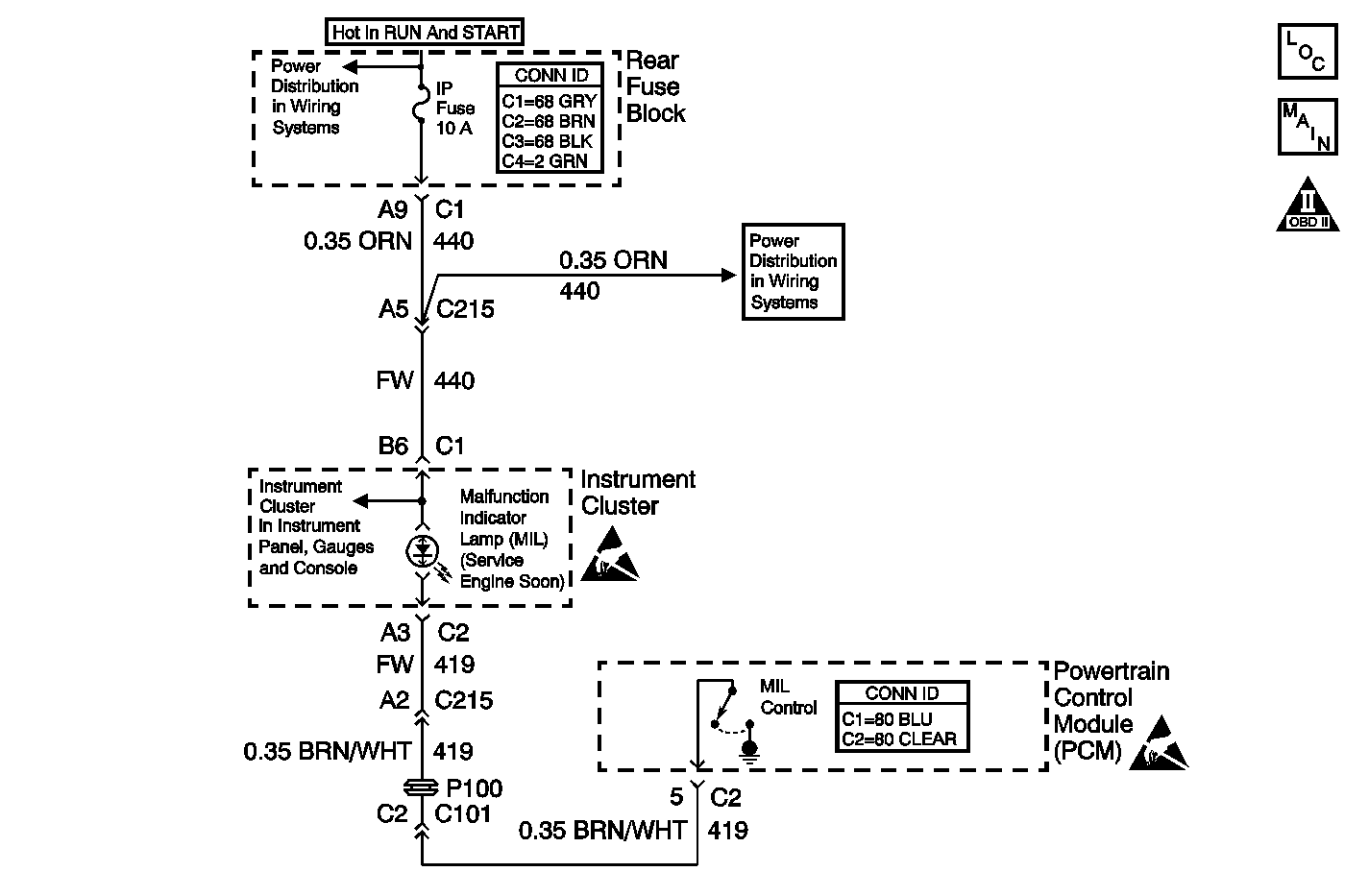
Circuit Description
Output driver modules (ODMs) are used by the PCM to turn on many of the current-driven devices that are needed to control various engine and Transaxle functions. Each ODM is capable of controlling up to 7 separate outputs by applying ground to the device which the PCM is commanding ON. Unlike the quad driver modules (QDMs) used in prior model years, ODMs have the capability of diagnosing each output circuit individually. DTC P0650 set indicates an improper voltage level on the output circuit that controls the malfunction indicator lamp (MIL).
Conditions for Running the DTC
The ignition is ON.
Conditions for Setting the DTC
| • | An incorrect voltage level has been detected on ODM D output 1 (the MIL control circuit). |
| • | The above conditions are present for at least 30 seconds. |
Action Taken When the DTC Sets
| • | The PCM does not illuminate the malfunction indicator lamp (MIL). |
| • | The PCM stores the conditions that were present when the DTC set as Fail Records data only. This information is not stored as Freeze Frame data. |
Conditions for Clearing the MIL/DTC
| • | A history DTC clears after 40 consecutive warm-up cycles have occurred without a malfunction. |
| • | DTC can be cleared by using the scan tool Clear Information function or by disconnecting the PCM battery feed. |
Diagnostic Aids
Check for the following conditions:
| • | A faulty connection at the PCM--Inspect harness connectors for backed out terminals, improper mating, broken locks, improperly formed or damaged terminals, and poor terminal to wire connections. Use a corresponding mating terminal to test for proper terminal tension. |
| • | A damaged harness--Inspect the wiring harness for damage. If the harness appears to be OK, disconnect the PCM, turn the ignition ON and observe a DMM connected between the MIL control circuit and ground at the PCM harness connector while moving connectors and wiring harnesses related to the MIL. A change in voltage will indicate the location of the malfunction. |
Reviewing the Fail Records vehicle mileage since the diagnostic test last failed may help determine how often the condition that caused the DTC to be set occurs. This may assist in diagnosing the condition.
Test Description
Numbers below refer to the step numbers on the Diagnostic Table.
Step | Action | Values | Yes | No |
|---|---|---|---|---|
1 | Did you perform the Powertrain On-Board Diagnostic (OBD) System Check? | -- | ||
2 |
Important: If the MIL fuse is open, locate and repair a short to ground in the MIL ignition supply circuit or a shorted cluster. Inspect the MIL fuse and replace as necessary. Was the fuse open? | -- | ||
3 |
Important: If the jumper fuse opens, locate and repair a short to voltage in the MIL control circuit or a shorted cluster. Is the MIL illuminated? | -- | ||
4 | Leaving the ignition ON, remove the jumper. Is the MIL illuminated? | -- | ||
5 |
Did you find and correct the condition? | -- | ||
6 | Test the MIL ignition supply circuit for an open and repair as necessary. Did you find and correct the condition? | -- | ||
7 |
Did you find and repair the condition? | -- | ||
8 | Inspect the cluster harness connector for faulty connections and repair as necessary. Refer to Wiring Repairs in Wiring Systems. Did you find and repair the condition? | -- | ||
9 | Inspect the PCM and the PCM harness connector for faulty connections and repair as necessary. Refer to Wiring Repairs in Wiring Systems. Did you find and correct the connection? | -- | ||
10 | Repair or replace the cluster. Refer to Instrument Cluster Replacement in Instrument Panel, Gauges, and Console. Did you complete the repair or replacement? | -- | -- | |
|
Important:: The replacement PCM must be programmed. Replace the PCM. Refer to Powertrain Control Module Replacement/Programming Did you complete the replacement? | -- | -- | ||
12 |
Does the DTC reset? | -- | System OK |
